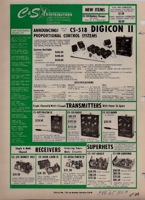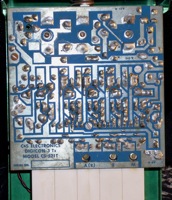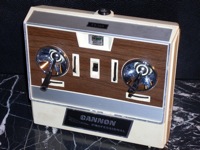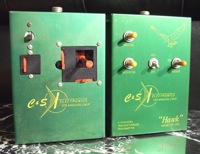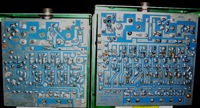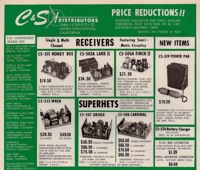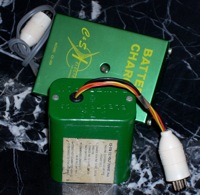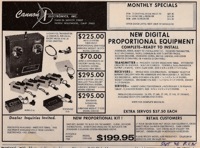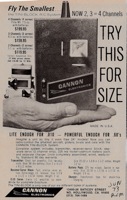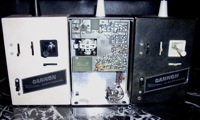Special Exhibit:
C&S Three Channel
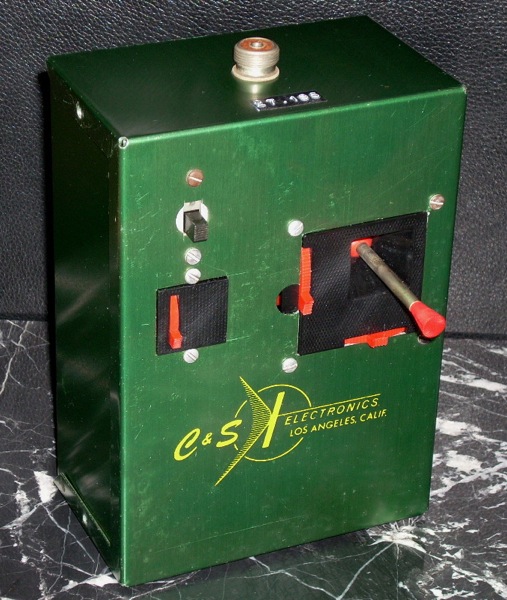
(Click on any of the images on this page to see a larger version)
This was the first C&S three channel proportional – the prototype. It was built by C&S owner Bill Cannon in 1965, to explore the feasibility of adding a budget, 3 channel option to the Digicon II line. To date, we have found no proof that C&S ever went on to produce or sell this system. This transmitter may not only be the first, but the only one of its kind.
The C&S Three Channel.
Notice that only 4 and 6 channel versions were offered in this ad. Subsequent ads also mentioned no Digicons except 4 and 6 channel models. This continued until the final ad in July 1966. Since there appears to be no advertising, there could well have been no production or sales of the Digicon 3 channel. However, a lack of publication advertising is not conclusive; sales may have been accomplished through other channels (e.g. catalogs). And we have one piece of evidence, suggesting at least some production. The circuit board. Here’s how it looks:
The circuit board is production quality with full factory finish. It does not suggest a one-only prototype the way the case does. It was not common to expend the time and effort necessary to make a production quality circuit board for a mere prototype. It is possible Cannon was a perfectionist when it came to circuit boards or it was simply his practice to make professional looking boards even in prototypes. Here’s another example where he did this, the prototype for what became the Cannon Executive:
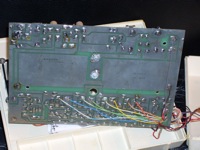 | 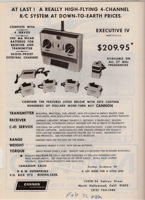 |
Reed Case
Contrast the C&S Three Channel circuit board with the transmitter’s case. For a prototype, manufacturers would often adapt an existing case to save time and money. Cannon used a C&S Hawk 6 channel reed transmitter case for this one.
Look closely and you can see where he erased the graphic of a hawk in the upper right hand corner and, at the bottom, the phrases: “Hawk Model CS-512” and “6 channel transistorized transmitter”. What he didn’t erase was the hole in the middle of the case for the on-off toggle switch and the hole in the upper left hand corner of the case for the motor control flipper switch (in which he placed the prototype on-off slide switch). Here, for comparison, is the Digicon 3 Prototype and a Hawk 6 channel, side by side:
The erased identification, remaining holes and tiny etch marks on the face laying out the proportional control lever cuts, all typify a prototype. But not the circuit board. Let’s take another look at it, this time alongside a Digicon II, 6 channel:
The Prototype is a smaller version, but every bit as finished and production – like as its big brother. Looking inside you can now confirm that what appears externally to be a three channel proportional, definitely is.
Nailing The Numbering
In addition to having three channels of components on the opposite side, the circuit board indicates aileron (or rudder) for the 1st channel and states “Digicon 3”. Its 521 model number places it immediately after the Digicon II, in time. C&S numbered its various systems serially, as they were developed. Thus, for example, the single channel Falcon transmitter was the CS-502, the C&S ten channel reeds was designated CS-510 and the subsequent 6 channel reed system the CS-512.
This had us worried for a time. Since the Digicon II was CS-518 and this prototype was CS-521, what came in between? Were the CS-519 and 520 intervening models with more channels or other features? Could the prototype three channel have been made much later than we thought, not until finishing the 519 and 520 models? Fortunately, all these questions are now clearly answered, as documented by this ad (Mar 65’ RCM):
This appeared just 1 month before the first Digicon II ad. It clearly shows that the 519 was a battery pack and the 520 its charger. The Digicon ads continue to refer to the 520 charger but no longer designate the battery pack as 519. That’s because, when sold with the Digicon (518) system, this pack carried a 518 label. The chargers kept their 520 designation and even had it printed on their cases. Here is an actual C&S battery pack (519 when sold generically for other systems, 518 when sold with the Digicon II), and charger:
Other 3 Channels
We do not know why C&S may have decided not to promote its three channel system or not to produce one at all. One big factor was probably the explosion of competition and lower prices which occurred at this point in RC history (See C&S One – “The Earth Shakes”). Cannon may have doubted his ability to produce and sell the systems profitably. Years later Cannon did produce three channel systems and sold them in substantial numbers.
In July 1967, it was announced Cannon Electronics would succeed C&S. In 1968, Cannon Electronics introduced its new line of proportional equipment. These systems were very different. They were much less expensive, had vinyl clad aluminum cases, single deck receivers and smaller, more modern electronics including integrated circuits. A three channel option was offered, although its transmitter came in a modified five channel case, as explained in this ad (Sept 68’ RCM):
In 1973, Cannon Electronics offered this smaller system in 2, 3 or 4 channels (July 73’ RCM):
Here are three of these Cannon three channels from our collection:



